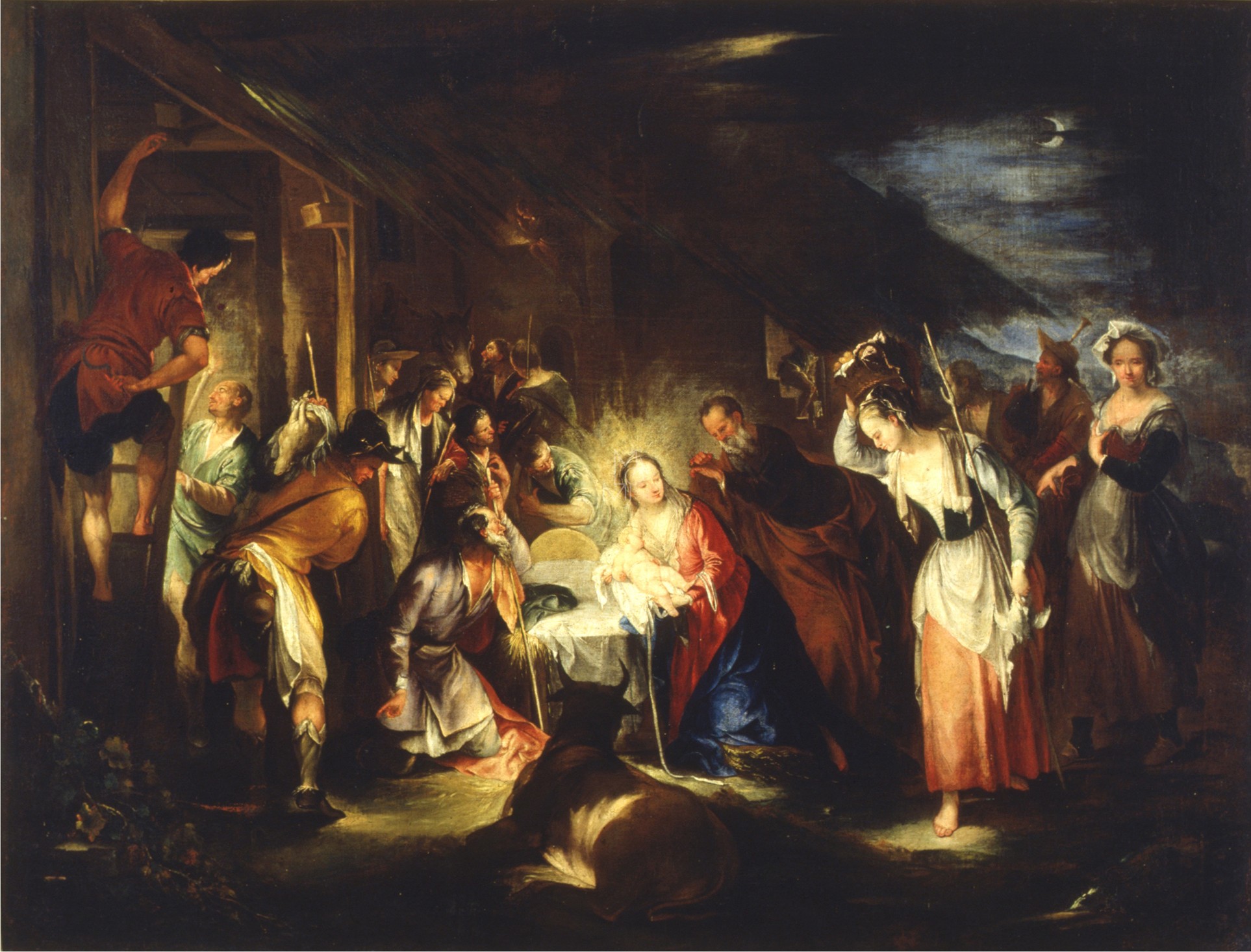ANDREA CELESTI 1637-1712
Andrea Celesti was active between Venice, the Garda Riviera and Brescia and was known above all for his works with a sacred subject, characterised by a delicate and luminous style influenced by the models of the great Venetian tradition of the 16th century, in particular those of Tintoretto and Paolo Veronese. In the mature phase of his production, the artist also approached Dutch painting, particularly that of Rembrandt, from which he borrowed a new use of light and a focus on the everyday aspects of popular life. These characteristics are also evident in this Adoration of the Shepherds with its nocturnal setting, illuminated almost exclusively by the divine light emanating from the Infant Jesus. The painting is an oil on canvas depicting the birth of Jesus within a large, sloping roofed hut, from which the cold light of a sky lit by a crescent moon filters, the scene of the Adoration of the Shepherds unfolds. In the centre, within a luminous halo, is Mary (behind whom is St. Joseph leaning on his staff), in adoration before the manger in which the Child is laid. Around the group of the Holy Family is a throng of shepherds, onlookers, commoners, caught in the most varied expressions.
Despite its imposing size, the painting is executed with extreme delicacy, with brushstrokes that seem almost on the point of melting. The same composition was reproposed by Celesti in the canvas now at the Pinacoteca Corrado Giaquinto in Bari (inv. no. 19), almost identical in size to the present one and datable to the last decade of the 17th century (A.M. Mucchi, C. Della Croce, Il pittore Andrea Celesti, Milan 1954, p. 90).
The work presented here is documented in the inventories of the collection of Girolamo Manfrin, a wealthy impresario active in the tobacco trade, who created one of the most important collections in Venice between the 18th and 19th centuries. Housed in the family palace in Cannaregio, the picture gallery was open to the public twice a week and is mentioned in all the city's guide books; it is also mentioned in the travel diaries of numerous men of letters and artists who visited it, such as George Byron, Jacob Burckhardt, Gustav Friedrich Waagen and Edouard Manet. Manfrin was particularly fond of 16th- and 17th-century Venetian painting, and among the most important paintings in his picture gallery were two canvases by Giorgione, The Old Man and the famous Tempest, both of which are now in the Gallerie dell'Accademia in Venice. Girolamo's collections, however, also included sculptures, books, prints and a scientific collection of fossils and shells, in the spirit of 'encyclopaedic' collecting.
The Adoration of the Shepherds by Andrea Celesti belongs to the original nucleus of the collection, which still has the labels and inventory references on the back, and is already mentioned in the first document conserved, an inventory compiled in 1794 by the restorer Pietro Edwards, Manfrin's collaborator and consultant (Abbozzi catalogo Galleria manfriniana 1794); it then appears in another inventory dated 1834, compiled after the death of Pietro Manfrin, Girolamo's son, at the time of the transfer of the property to his sister Giulia Angela Giovanna. Both documents mention the existence of a pendant depicting The Multiplication of the Loaves, currently untraced.
The dispersal of the Manfrin collections began around the middle of the 19th century, with a first sale in Venice in 1856, followed by further auctions in Paris (1870) and Milan (1897). The works were contested by eminent private collectors, mainly British and American, and by the most important European museums: the National Gallery and the Louvre entered into negotiations with the Manfrin heirs for the purchase of blocks of the collection. However, a considerable number of paintings remained at home, acquired by the Gallerie dell'Accademia in Venice. For the present painting, as recalled in Francesco Zanotto's volume on the history of Venetian painting published in 1880. "the two truly distinct paintings, one with the Birth of Jesus, the other with the Multiplication of the Loaves" from the Manfrin Gallery ended up in Spain, where they may have been sold at auction. Andrea Celesti was active between Venice, the Garda Riviera and Brescia and became famous above all for his works on sacred subjects, characterised by a delicate and luminous style influenced by the models of the great Venetian tradition of the 16th century, particularly those of Tintoretto and Paolo Veronese. In the mature phase of his production, the artist also approached Dutch painting, particularly that of Rembrandt, from which he borrowed a new use of light and a focus on the everyday aspects of popular life. These characteristics are also evident in this Adoration of the Shepherds with its nocturnal setting, illuminated almost exclusively by the divine light emanating from the Infant Jesus. Despite its imposing size, the painting is executed with extreme delicacy, with brushstrokes that seem almost on the verge of melting away. The same composition was reproposed by Celesti in the canvas now at the Corrado Giaquinto Art Gallery in Bari (inv. no. 19), almost identical in size to the present one and datable to the last decade of the 17th century (A.M. Mucchi, C. Della Croce, Il pittore Andrea Celesti, Milan 1954, p. 90).
Restoration of use
Dimensions in centimetres
Length 200
Depth
Height 148.5
